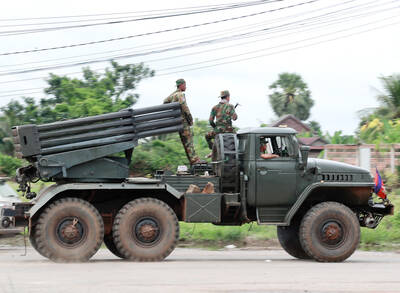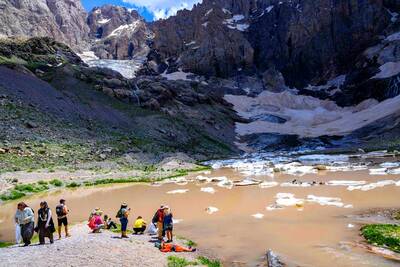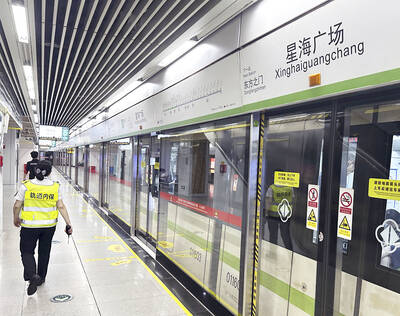Volcanic eruptions have periodically cooled the tropics over at least the last 450 years by spewing out particles that girdle the world at high altitude and reflect sunlight, a study released yesterday said.
The research adds a chunk of regional evidence to earlier work that found major eruptions — such as Krakatoa, Indonesia in 1883 and Huaynaputina, Peru in 1600 — contribute to cooling on a worldwide scale.
A trio of scientists led by Rosanne D’Arrigo of the Lamont-Doherty Earth Observatory in Palisades, New York, looked at ocean temperatures in a belt extending from 30 degrees south across the equator to 30 degrees north.
They compiled temperature records reaching back nearly half a millennium from three sources: ice cores, tree rings and coral reefs.
They found the longest sustained period of cooling of sea surfaces — to a depth of 1m — occurred in the early 1800s following the eruption of Mount Tambora on the Indonesia island of Sumbawa.
Tambora blew its top in 1815 and was the most powerful eruption in recorded history, the US Geological Survey said. But links between volcanic activity and cooler ocean surfaces weakened in the 20th century, apparently as a result of global warming from the burning of fossil fuels, the researchers said.
Another study, also published online in the journal Nature Geoscience, points to a previously unrecognized potential driver of climate change.
Intensive, chemical-laden agriculture could trigger the release of carbon dioxide from river systems, Henry Wilson and Marguerite Xenopoulos of Trent University in Ontario, Canada argue.
The researchers examined organic matter that had dissolved in 34 rivers in Ontario.
Some of the rivers were pristine and others were heavily polluted by runoff from agricultural chemicals such as fertilizers. Pollution from these chemicals meant the organic material was likelier to release its carbon into the atmosphere, the study said.

In the sweltering streets of Jakarta, buskers carry towering, hollow puppets and pass around a bucket for donations. Now, they fear becoming outlaws. City authorities said they would crack down on use of the sacred ondel-ondel puppets, which can stand as tall as a truck, and they are drafting legislation to remove what they view as a street nuisance. Performances featuring the puppets — originally used by Jakarta’s Betawi people to ward off evil spirits — would be allowed only at set events. The ban could leave many ondel-ondel buskers in Jakarta jobless. “I am confused and anxious. I fear getting raided or even

POLITICAL PATRIARCHS: Recent clashes between Thailand and Cambodia are driven by an escalating feud between rival political families, analysts say The dispute over Thailand and Cambodia’s contested border, which dates back more than a century to disagreements over colonial-era maps, has broken into conflict before. However, the most recent clashes, which erupted on Thursday, have been fueled by another factor: a bitter feud between two powerful political patriarchs. Cambodian Senate President and former prime minister Hun Sen, 72, and former Thai prime minister Thaksin Shinawatra, 76, were once such close friends that they reportedly called one another brothers. Hun Sen has, over the years, supported Thaksin’s family during their long-running power struggle with Thailand’s military. Thaksin and his sister Yingluck stayed

Kemal Ozdemir looked up at the bare peaks of Mount Cilo in Turkey’s Kurdish majority southeast. “There were glaciers 10 years ago,” he recalled under a cloudless sky. A mountain guide for 15 years, Ozdemir then turned toward the torrent carrying dozens of blocks of ice below a slope covered with grass and rocks — a sign of glacier loss being exacerbated by global warming. “You can see that there are quite a few pieces of glacier in the water right now ... the reason why the waterfalls flow lushly actually shows us how fast the ice is melting,” he said.

RISING RACISM: A Japanese group called on China to assure safety in the country, while the Chinese embassy in Tokyo urged action against a ‘surge in xenophobia’ A Japanese woman living in China was attacked and injured by a man in a subway station in Suzhou, China, Japanese media said, hours after two Chinese men were seriously injured in violence in Tokyo. The attacks on Thursday raised concern about xenophobic sentiment in China and Japan that have been blamed for assaults in both countries. It was the third attack involving Japanese living in China since last year. In the two previous cases in China, Chinese authorities have insisted they were isolated incidents. Japanese broadcaster NHK did not identify the woman injured in Suzhou by name, but, citing the Japanese